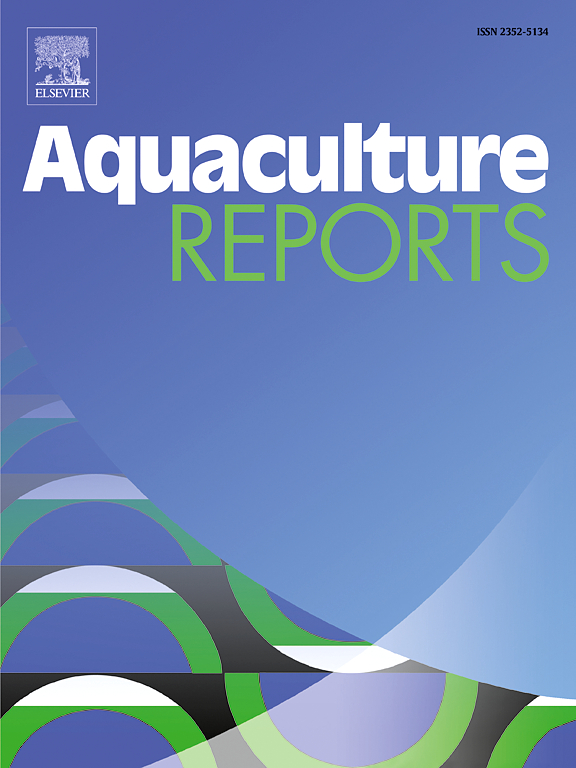碱化处理对凡纳滨对虾养殖生物群落动态和生长性能的影响
IF 3.2
2区 农林科学
Q1 FISHERIES
引用次数: 0
摘要
生物絮团技术是生态友好的,因为它在水产养殖中的水交换最少。然而,由于生物絮团孵化过程中产生的有机酸,它可能会降低池塘水的碱度。本研究评估了caco3 (C)、MgCO3 (M)及其组合(MC)三种碱度处理对凡纳滨对虾水质、生物絮团孵化和生长的影响。处理C和M的剂量为20 mg L−1,而MC的剂量为10 mg L−1。仔虾初始体重为0.044 ± 0.01 g,培养52 d。与对照组相比,MC处理显著增加了菌群密度,但处理间差异不显著。第10、25和30天,M和MC中铵态氮含量低于对照,而M和MC中硝态氮含量高于对照。所有处理的总硬度均高于对照组,但处理间无显著差异。虾在治疗C显示明显高于体重增加(0.21 ±0.03 g)治疗相比,M和MC(0.19 ± 0.003和0.20±0.02 g)和更好的食物转换比率(1.27 ±0.2 )治疗相比,M(1.42 ±0.02 )。同时,两种治疗方法的存活率没有显著差异。综上所述,添加C比添加M和MC更有利于对虾的生长。总体而言,M和MC处理提高了水质和生物絮团水平,而C对对虾的生长最有效。本文章由计算机程序翻译,如有差异,请以英文原文为准。
Impact of alkalinity treatments on biofloc dynamics and growth performance in Penaeus vannamei shrimp culture
Biofloc technology is eco-friendly due to its minimal water exchange in aquaculture. However, it may lower alkalinity in pond water due to organic acids produced during biofloc incubation. This study assessed the effects of three alkalinity treatments—CaCO3 (C), MgCO3 (M), and their combination (MC)—on water quality, biofloc incubation, and Penaeus vannamei shrimp growth. Treatments C and M were dosed at 20 mg L−1, while MC combined 10 mg L−1 of each compound. Shrimp larvae with an initial weight of 0.044 ± 0.01 g were cultured for 52 days. Treatment MC significantly increased floc densities compared to the control, although differences among treatments were not significant. Ammonium levels in M and MC were lower than the control on days 10, 25, and 30, while nitrate levels in M and MC were higher. Total hardness was higher in all treatments compared to the control but did not differ significantly among treatments. Shrimp in treatment C showed significantly higher weight gains (0.21 ± 0.03 g) compared to treatments M and MC (0.19 ± 0.003 and 0.20 ± 0.02 g, respectively) and better food conversion ratios (1.27 ± 0.2) compared to treatment M (1.42 ± 0.02). Meanwhile, survival rates did not vary significantly between treatments. It indicates that the addition of C is better for shrimp growth than with M and MC. Overall, M and MC treatments enhanced water quality and biofloc levels, while C was most effective for shrimp growth.
求助全文
通过发布文献求助,成功后即可免费获取论文全文。
去求助
来源期刊

Aquaculture Reports
Agricultural and Biological Sciences-Animal Science and Zoology
CiteScore
5.90
自引率
8.10%
发文量
469
审稿时长
77 days
期刊介绍:
Aquaculture Reports will publish original research papers and reviews documenting outstanding science with a regional context and focus, answering the need for high quality information on novel species, systems and regions in emerging areas of aquaculture research and development, such as integrated multi-trophic aquaculture, urban aquaculture, ornamental, unfed aquaculture, offshore aquaculture and others. Papers having industry research as priority and encompassing product development research or current industry practice are encouraged.
 求助内容:
求助内容: 应助结果提醒方式:
应助结果提醒方式:


